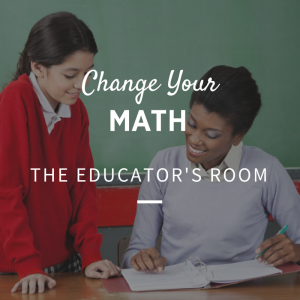 I love math! In high school, however, I remember we were asked to show ALL work. There were things I was just doing in my mind that I had never been asked to break down or explain. This was a difficult task, but it made me push myself to understand the process. No longer was I memorizing a procedure and going through the motions, now I was applying learning and explaining my thinking. It sucked!
I love math! In high school, however, I remember we were asked to show ALL work. There were things I was just doing in my mind that I had never been asked to break down or explain. This was a difficult task, but it made me push myself to understand the process. No longer was I memorizing a procedure and going through the motions, now I was applying learning and explaining my thinking. It sucked!
I spent the first 12 years of my teaching career in kindergarten and first grade. The math skills we covered got as complex as “carrying” and “borrowing” in addition and subtraction. I felt very knowledgeable in these skills; there are so many important skills introduced in these formative years for number sense. As I have since seen my own children go through elementary school and I have worked with struggling upper elementary students, I am amazed at what number sense is. Just as in my high school trigonometry class, we need to be asking students to apply and explain their math thinking. We have moved beyond memorization and rote recall. This is enabling our students to manipulate and understand numbers at a higher level. It is also confusing parents.
This week our school is offering a class for families on Monday night. Families are going to get to see how their upper elementary students are learning math. We hope to explain to families how addition, subtraction and multiplication follow a progression of understanding through number sense. The “Crazy New Math” enables students to become accurate mathematicians who will apply this knowledge. Here is a quick overview:
Base 10–students use base 10 pieces or virtual manipulatives to represent numbers. We want students to see “48” as forty and eight, not 4 8. It is important to develop this sight of numbers so students are successful when they begin adding and subtracting larger pieces. When they begin to add and subtract they can use these tools to compose and decompose numbers.
Number Line–students use a number line to represent numbers. We want students to see (as they add or subtract) the numbers get larger or smaller. We want them to see the progression. For early elementary students it is fun to make number lines on the floor and actually walk on them. Students can hop along the number line quite literally or using a written number line and a pencil. Any number combinations can be used, we encourage students to use place value to strengthen their number sense though.
Expanded Form–students write the numbers in expanded form with their 0 holders to show place value, expanding each number. We want students to see the numbers in their place value such as “36” as 30 + 6 and not 3 6. This is a natural progression from the base 10 knowledge. It allows students to add the ones, tens, hundreds, etc. separately and decreases the confusion from carrying and borrowing. It is important to understand when you subtract you are borrowing groups of numbers, not 1 from the 10s. Expanded form shows this process.
Partial Product–students compute numbers with the answers written in partial products (under the equal sign). We want students to see the place value of each answer as they compute. This step is a natural progression from expanded form. It allows students to see the answers instead of carrying the larger digits. Instead of needing to expand each number, however, the place value is represented with the answer.
Standard Algorithm–students compute numbers in standard form (old school). This is a natural progression from partial product as students master place value and fact practice. They have a secure understanding of the numbers and can carry the larger place value instead of needing to see it written under the equation.
When I began teaching conceptual math I had a lot of learning to do. I could add and subtract with standard algorithm. I could carry and borrow. I was not, however, thinking of numbers in terms of number sense. I have seen, however, in the past five years of using conceptual math in my classroom that my students have become quick and accurate as they progress through the steps above. Some students need the understanding and practice at the expanded form longer than others. Some students progress through quickly and understand the standard algorithm with less practice. Each student, however, given the opportunity to work though the conceptual math model on their own will develop their understanding of number sense and become efficient in addition and subtraction of larger numbers.
This week I hope to open the eyes of our families. I hope to provide them with some vocabulary and understanding of how their children work. At home it is important to be able to work with your children, but don’t be afraid to LEARN with them too. We will share some methods, apps, games, and frustration as parents change their math.
Check out the Presentation for Change Your Math in my Teachers Pay Teachers store. It is 24 slides with links, video examples and information about multi-digit addition/subtraction and multi-digit multiplication. This is designed to be used as a presentation for parents in a school format. It could also be viewed by parents on their own to understand conceptual teaching.




